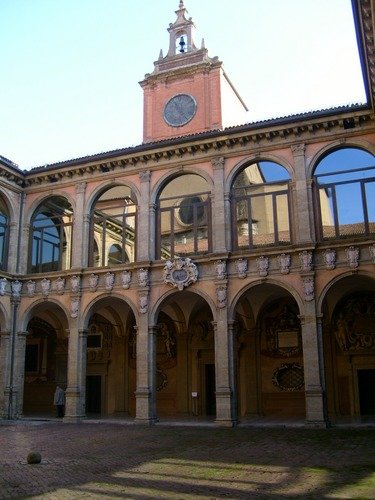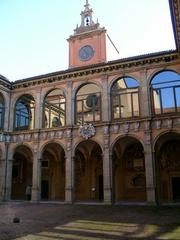
Palazzo dell’Archiginnasio: Visiting Hours, Tickets, and Ultimate Bologna Historical Guide
Date: 15/06/2025
Introduction
Nestled in the heart of Bologna’s historic center, the Palazzo dell’Archiginnasio is a monument to the city’s centuries-old academic and civic traditions. Constructed in the 16th century as the first unified seat of the University of Bologna—the world’s oldest university—the Archiginnasio embodies Renaissance ideals, Baroque artistry, and a unique intellectual legacy. Today, it welcomes visitors to explore its grand architecture, the renowned Anatomical Theatre, and a wealth of artistic and heraldic treasures. This in-depth guide covers everything you need to know: history, highlights, visiting hours, ticketing, accessibility, nearby attractions, and practical travel tips (Musei di Bologna; Our Italian Journey).
Table of Contents
- Historical Overview
- Visiting the Palazzo dell’Archiginnasio
- Nearby Attractions and Itinerary Suggestions
- Frequently Asked Questions (FAQ)
- Visuals and Media Suggestions
- Conclusion and Call to Action
- References
Historical Overview
Origins and Construction
The Palazzo dell’Archiginnasio was built rapidly between 1562 and 1563, commissioned by Cardinal Carlo Borromeo and designed by Antonio Morandi “Il Terribilia.” Its purpose was to centralize the University of Bologna’s scattered faculties into a single, prestigious hub, as part of reforms inspired by the Council of Trent (Baroque Art Museum). The building’s completion marked a new era for European higher education, positioning Bologna as a beacon of scholarship (Our Italian Journey).
Architectural and Artistic Significance
The Archiginnasio’s architecture is a model of Renaissance harmony, with a grand portico of 30 arches spanning two floors and a central courtyard framed by arcaded loggias (Baroque Art Museum). The walls and ceilings are adorned with more than 6,000 coats of arms—one of the world’s most extensive heraldic displays—commemorating generations of students and professors from across Europe. Artistic highlights include terracotta sculptures, frescoes by Bartolomeo Cesi, and Baroque monuments such as the double portrait of the Fornasari brothers (Our Italian Journey).
The Anatomical Theatre: Science Meets Art
A masterpiece of Baroque woodwork, the Anatomical Theatre (Teatro Anatomico) was constructed in 1637 by Antonio Levanti for medical instruction. Amphitheater-style tiers surround a marble dissection table, with wooden statues of famed physicians and anatomists gazing down. The “Spellati” (skinned men), carved by Silvestro Giannotti in 1734, vividly illustrate human musculature and support the professor’s canopy. The coffered ceiling, featuring Apollo and zodiac signs, links medicine to the broader cosmos (Nomads Travel Guide; Medicine Museum).
The Stabat Mater Hall
This elegant upper-floor hall, named for Rossini’s first Italian performance of “Stabat Mater” in 1842, was the university’s main law lecture room. It features a vaulted ceiling, rich heraldic decorations, and grand proportions that reflect its academic importance (Our Italian Journey).
The Archiginnasio Library
Since 1838, the palace has housed the Biblioteca Comunale dell’Archiginnasio, one of Italy’s leading public libraries. Its collection exceeds 850,000 volumes, including manuscripts and rare editions pivotal to Bologna’s intellectual heritage. While the library is not open to tourists, it remains a hub for researchers and students (Archiginnasio Official).
Symbolism and Civic Identity
The Archiginnasio’s vast heraldic program—6,000+ coats of arms and inscriptions—celebrates Bologna’s cosmopolitan academic community. Each crest commemorates student “nations” and distinguished scholars, reflecting the university’s role in shaping civic and European identity (Cestee).
Resilience and Restoration
The palace suffered extensive damage in a 1944 air raid, with the Anatomical Theatre nearly destroyed. A meticulous postwar restoration, using salvaged fragments, revived the site and preserved its unique blend of academic and artistic heritage (PMC).
Visiting the Palazzo dell’Archiginnasio
Opening Hours and Ticketing
- Palazzo dell’Archiginnasio: Open daily except Sundays.
- Teatro Anatomico & Sala dello Stabat Mater: Open for visits, closed on Sundays and public holidays. Advance booking is recommended and required on Saturdays and holidays.
- Library: Not open for general tourism; reserved for researchers and students.
Typical Hours (verify before your visit):
- Monday–Saturday: 9:00 AM–7:00 PM
- Sundays/Public Holidays: Closed or 10:00 AM–6:00 PM
Tickets:
- General admission for the Anatomical Theatre & Stabat Mater Hall: €5
- Reduced (students, seniors): €3
- Free for children under 18 and Bologna residents
- Purchase tickets online via the official portal (non-refundable, €0.50 surcharge), through Tiqets, or at the entrance (Tiqets).
Accessibility and Visitor Facilities
- Wheelchair Access: Ramps and elevators are available, though some historic areas have limited access.
- Restrooms: Public facilities on-site.
- Cloakroom: Not available; large bags may be restricted.
- Language: Information panels in Italian and English; audioguides in multiple languages.
- Photography: Non-flash photography permitted in most areas (check for event-specific restrictions).
Guided Tours and Events
- Guided Tours: Offered in several languages, often including the Anatomical Theatre and Stabat Mater Hall. Advance booking recommended (GetYourGuide).
- Audioguides: Available with some ticket packages.
- Special Events: The palace hosts concerts, exhibitions, and cultural events—consult the official events page for updates.
Practical Visitor Tips
- Recommended Visit Time: 1–1.5 hours
- Best Times: Mornings and weekdays are less crowded.
- Food & Drink: No on-site cafés, but plenty of options nearby in Piazza Maggiore and Via dell’Archiginnasio.
- Supervision: Children should be supervised, especially near delicate woodwork and artifacts.
Nearby Attractions and Itinerary Suggestions
The Archiginnasio’s central location makes it easy to combine with other Bologna landmarks:
- Basilica di San Petronio (0.08 miles)
- Museo Civico Archeologico (0.05 miles)
- Piazza Maggiore (0.12 miles)
- Casa di Lucio Dalla (0.08 miles)
- Basilica di Santo Stefano (0.26 miles)
Frequently Asked Questions (FAQ)
Q: Is the Palazzo dell’Archiginnasio open on Sundays?
A: Generally closed on Sundays, including the Anatomical Theatre and library. Always check current hours before your visit.
Q: Can I visit the Biblioteca Comunale dell’Archiginnasio?
A: The library is accessible only to researchers and students, not open for general tourism.
Q: Are guided tours available in English?
A: Yes, both guided tours and audioguides are offered in multiple languages.
Q: Is the site wheelchair accessible?
A: The main areas are accessible, though some historical rooms may have limitations.
Q: How do I get tickets?
A: Purchase online via the official portal or at the entrance.
Visuals and Media Suggestions
Enhance your visit with high-quality images of the façade, Anatomical Theatre, and heraldic walls. For accessibility and SEO, use alt text such as “Palazzo dell’Archiginnasio Bologna façade” or “Anatomical Theatre wooden sculptures.” Virtual tours and downloadable maps are available on the official website.
Conclusion and Call to Action
The Palazzo dell’Archiginnasio is a living testament to Bologna’s legacy as a center of European learning and culture. From its Renaissance architecture and lavish heraldic displays to the unique Anatomical Theatre and vibrant event program, it offers an enriching experience for every visitor. To maximize your visit:
- Book tickets online and check for updated hours and events.
- Allow enough time to explore the key halls and architectural features.
- Consider a guided tour for deeper historical context.
- Explore nearby attractions to complete your Bologna itinerary.
Stay informed about special exhibitions and events by following official channels and downloading the Audiala app for immersive audio tours.
Embark on a journey through centuries of knowledge, artistry, and civic pride at the Palazzo dell’Archiginnasio—an essential Bologna destination.
References
- Palazzo dell’Archiginnasio: A Must-Visit Bologna Historical Site with Visiting Hours, Tickets, and Visitor Tips (Musei di Bologna)
- Palazzo dell’Archiginnasio in Bologna: Architecture, Art, and Visitor Guide (Our Italian Journey)
- Archiginnasio Bologna: Visiting Hours, Tickets, and Historical Insights (PMC)
- Archiginnasio Bologna: Visiting Hours, Tickets, and Historical Insights (Lonely Planet)
- Palazzo dell’Archiginnasio Visitor Information and Practical Tips (Tiqets)
- Palazzo dell’Archiginnasio Visitor Information and Practical Tips (GetYourGuide)
- Palazzo dell’Archiginnasio in Bologna: Architecture, Art, and Visitor Guide (Baroque Art Museum)
- Archiginnasio Bologna: Visiting Hours, Tickets, and Historical Insights (Nomads Travel Guide)
- Archiginnasio Bologna: Visiting Hours, Tickets, and Historical Insights (Medicine Museum)
- Symbolism and Civic Identity (Cestee)
































